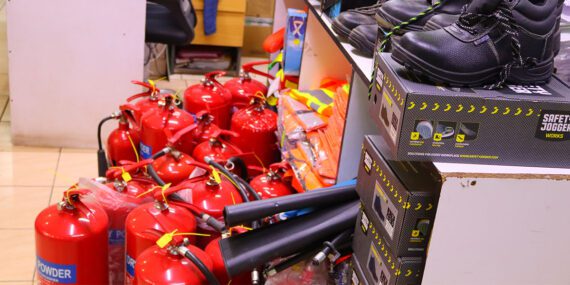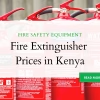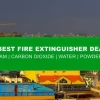- Empty cart.
- Continue Shopping
Different types of Fire Extinguishers in Kenya
Welcome to our comprehensive guide on different types of fire extinguishers in Kenya.
Whether you’re a homeowner, business owner, or just curious about fire safety, understanding the different types of fire extinguishers and their specific uses is crucial in ensuring preparedness in the event of a fire.
In this guide, we’ll explore different types of fire extinguishers options available in Kenya, explain how they work, and discuss the best practices for their use in different settings.
Stick around to learn how to keep your environment safe!
Different types of Fire Extinguishers
At Safety Hub Limited we offer a wide collection of different types of fire extinguishers which are classified in various classes.
The different types of fire extinguishers include:
- Water fire extinguisher
- Water chemical extinguisher
- Carbon Dioxide fire extinguisher
- ABC fire extinguisher
- Foam fire extinguisher
Water-Based Fire Extinguishers
Water-based fire extinguishers are among the most common types used in Kenya. They are effective for tackling Class A fires, which include fires that involve solid combustibles like wood, paper, and textiles.
These extinguishers extinguish flames by cooling the burning material below its ignition temperature and soaking the fibers to prevent re-ignition.
It’s important to note that they should not be used on grease or electrical fires as they can spread the fire or cause electrocution.
Foam Fire Extinguishers
Foam fire extinguishers are versatile and suitable for handling both Class A (solids) and Class B (flammable liquids) fires.
They work by creating a foam blanket over the burning material, effectively cutting off the oxygen supply and preventing the release of flammable vapors.
In Kenya, these different types of fire extinguishers are particularly useful in places with risks of liquid fires, such as kitchens or near fuel storage areas.
However, similar to water-based extinguishers, they are not recommended for use on electrical fires.
Dry Powder Fire Extinguishers
Dry powder fire extinguishers are recognized for their ability to tackle most types of fires, making them ideal for locations in Kenya where multiple fire risks exist.
They can be used on Class A, B, and C fires, which include gases in addition to solids and liquids. The powder works by interrupting the chemical reaction that occurs during a fire.
These extinguishers are particularly useful for their versatility but can create visibility and breathing problems, hence it’s advisable to use them in well-ventilated areas.
Carbon Dioxide (CO2) Fire Extinguishers
Carbon Dioxide (CO2) fire extinguishers are excellent for fires involving electrical equipment as they leave behind no residue that could further harm the equipment.
They work by displacing oxygen in the air around the fire, effectively smothering it. In Kenya, CO2 extinguishers are commonly found in IT server rooms, laboratories, and areas where electrical fires are a significant risk.
They are not suitable for Class A or Class B fires since they do not cool the fire, allowing it to potentially re-ignite.
Wet Chemical Fire Extinguishers
Wet chemical fire extinguishers are specially type of fire extinguishers designed for Class F fires, commonly seen in cooking and kitchen settings where cooking oils and fats are present.
They work by creating a soap-like solution that cools and emulsifies the burning oil or fat, effectively stopping the fire.
In Kenya, these are essential in commercial kitchens, restaurants, and anywhere large amounts of cooking oils are used.
Uses of Fire Extinguishers in Kenya
Fire extinguishers are suitable for use in different setting as seen below.
Residential Settings
In residential settings across Kenya, fire extinguishers are crucial for ensuring the safety of homes and families.
Typically, a multi-purpose dry powder or foam extinguisher is recommended due to its ability to handle various fire types.
Residents are encouraged to keep at least one extinguisher in accessible locations like the kitchen or near fire sources such as electrical panels or heating units.
Commercial Buildings
Commercial buildings in Kenya, including offices, shopping centers, and theaters, often require a range of fire extinguishers to meet different needs.
Carbon dioxide extinguishers are commonly used in areas with a lot of electrical equipment, while foam extinguishers might be found in storage areas where flammable liquids are kept.
Ensuring the right type of extinguisher is available and all staff are trained on how to use them is key to maintaining safety.
Industrial Areas
In industrial settings, the presence of highly flammable materials means that the risk of severe fires can be particularly high.
Dry powder extinguishers are often favored here for their ability to suppress many types of fires quickly.
Depending on the specific industry, wet chemical extinguishers might also be necessary where cooking or processing of oils and fats is involved.
Regular training and drills are essential to equip workers with the knowledge to handle fire emergencies effectively.
Importance of Proper Fire Extinguisher Training
Having the right fire extinguisher on hand can undoubtedly save lives and property, but it’s just as crucial to know how to use it effectively.
Proper training ensures that individuals can act quickly and efficiently in a fire emergency, reducing the risk of injury or death and preventing minor fires from escalating into major disasters.
In Kenya, many organizations and educational facilities offer fire extinguisher training to empower individuals with the knowledge to tackle various types of fires safely. This training typically includes:
- Identifying the types of fire extinguishers and their specific uses.
- Understanding the classes of fires (Class A, B, C, D, and K) and the appropriate extinguisher for each class.
- The PASS technique (Pull, Aim, Squeeze, Sweep) used to operate most fire extinguishers effectively.
- Maintenance checks and when to replace or service a fire extinguisher.
The benefits of this training extend beyond mere safety.
Employees who are trained contribute to a safer workplace, which can enhance confidence among staff members and potentially reduce insurance premiums for the organization.
In homes, knowing how to use a fire extinguisher can make a noticeable difference in preventing damage and protecting families until professional help arrives.
Regulations and Guidelines for Fire Extinguishers in Kenya
In Kenya, the use and maintenance of fire extinguishers are regulated to ensure safety in both residential and commercial settings.
The Kenya Bureau of Standards (KEBS) sets the benchmarks for fire safety equipment and their operation, ensuring all units meet specific quality and safety standards.
Fire extinguishers in Kenya must adhere to the following guidelines:
- Every commercial building and public space is required to have an adequate number of fire extinguishers accessible and visible at all times.
- Fire extinguishers should be inspected and serviced annually by a certified professional to ensure they remain in working condition.
- All fire extinguishers must be installed in compliance with the Kenya National Fire Safety and Prevention Policy.
- Facility owners must ensure that occupants or employees are educated on the location and use of all fire extinguishers on the premises.
These regulations are enforced to help prevent fire accidents and manage risks effectively in workplaces and public areas.
Non-compliance can result in legal consequences, including fines or more severe penalties depending on the nature of the oversight.
Business owners, facility managers, and even homeowners should not only comply with these regulations but should also stay informed about any updates or changes to ensure continuous compliance and safety.
Regular training sessions and updates on fire extinguisher usage can also be beneficial, ensuring that all individuals remain knowledgeable about how to respond effectively in the event of a fire.
In summary, fire extinguishers are essential tools in fire prevention and safety in Kenya. However, possessing the right types and numbers of fire extinguishers is only part of the solution.
Regular maintenance, proper training on their use, and adherence to local regulations are equally important to ensure they function effectively when needed.
By understanding and implementing these practices, individuals and organizations in Kenya can significantly contribute to a safer environment for everyone.
Maintenance and Inspection of Fire Extinguishers
Ensuring that fire extinguishers are properly maintained and regularly inspected is crucial for their effectiveness in case of a fire.
In Kenya, both individuals and businesses must adhere to specific guidelines to keep these devices in working order.
Routine Maintenance
Routine maintenance of different types of fire extinguishers involves several key actions:
– Visual Inspection: This should be done at least once a month. Check for any signs of physical damage, corrosion, leakage, or a clogged nozzle.
The pressure gauge should be checked to ensure that the needle is in the green zone, indicating that the extinguisher is ready for use.
– Weight Check: Occasionally, an extinguisher should be weighed to ensure that it has not lost any of its fire-fighting substance through leakage or any other reasons.
– Documentation: Keep a record of all inspections, maintenances, and uses. This helps in tracking the unit’s lifespan and any recurrent issues that might suggest a replacement is necessary.
Professional Inspection
While regular checks can be performed by just about anyone after proper instruction, there are aspects of inspection that require professional expertise:
– Annual Check-up: A certified technician should inspect each extinguisher annually.
During this check-up, besides the regular checks, the technician will also conduct internal examination and tests like hydrostatic tests on certain types of extinguishers to confirm their integrity and functionality.
– Recharging: After any use, even if only partially, a fire extinguisher must be recharged by a professional. This process involves refilling the extinguishing agent and pressurizing the canister.
– Replacement:
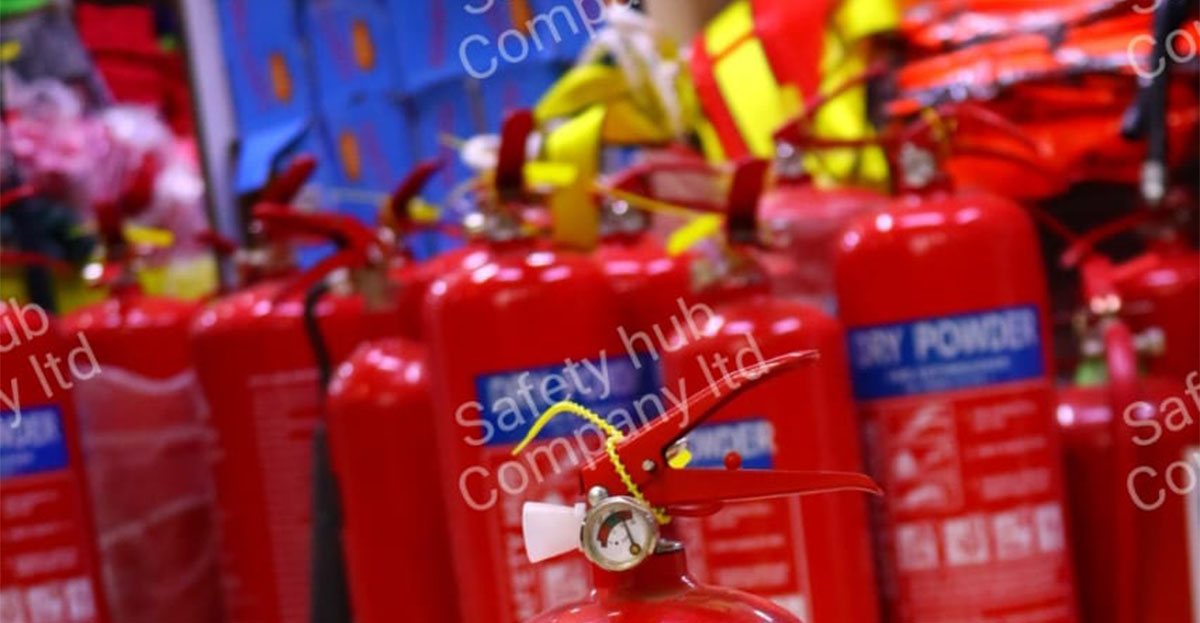
Professionals can determine when an extinguisher no longer complies with current safety standards or is deemed unreliable due to age or wear and tear. T
hey can advise when a replacement is necessary and what type of extinguisher would best suit the particular environment.
Regular and proficient maintenance and inspection not only extend the life of the fire extinguishers but also ensure that they will function effectively when needed, potentially saving lives and property.
Must Read Safety Articles
Conclusion on different types of fire extinguishers in Kenya
In Kenya, understanding the different types of fire extinguishers and their specific uses is crucial for effectively combating fires and ensuring safety in homes, businesses, and public areas.
Whether it’s an ABC extinguisher handling multiple fire types or a CO2 extinguisher used for electrical fires, selecting the right extinguisher is key to maintaining safety.
Always remember, the initial step in fire safety is not just having the right fire extinguisher, but also knowing how to use it correctly. Stay informed, stay prepared, and help create a safer environment for everyone.

